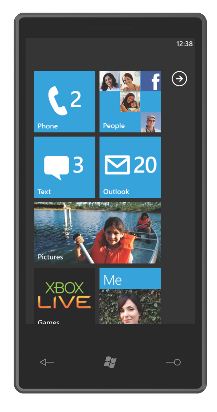It’s hot at the Mobile World Congress 2010, in Barcelona, as Microsoft officially unveils its latest and probably biggest Windows Phone 7 series, a new and pretentious Windows Mobile rendition, identical to all carriers and future device brands, with Qualcomm’s Snapdragon architecture onboard, handling smoothly the featured (unsized) capacitive touchscreens, built into those dev demo prototype phones. Basically, it’s a a whole new mobile system Redmond has literally built from the scratch and tweaked to be used on mobile machines in a way that you’ve never seen before. True, it would likely take time to get used to the 7 series, but its harmonic look and feel is surprisingly refreshing and conveniently flows. Yes, if you had this “deja vu” feeling of a Zune HD interface control, you’re probably not alone, but Microsoft has taken it few steps forward and created more in-depth platform with many new features like Xbox Live integration, social networking interaction, myriad of apps and widgets installed. “Every Windows series phone will be a Zune”, that’s what we’ve been told, and synchronizing your handheld music with PC computers is claimed to be very easy and simple to work.
The home screen itself includes dynamic vertical tiles, with customizable shortcut links to variant apps, contacts and other in-house modes, designed in a way you can flip them down from head to toe, but also pan left and right to sub-directories and other hidden rows. It boasts that same big and bold Zune HD text style, which relatively changes and gets magnified the moment you slide the screen and start to scroll. And navigating between the menus makes you realize that Microsoft completely revamped the OS code, making it concentrate in four major segments: People, Games, Pictures, Music plus Video hub homes. Each hub is an independent unit that’s responsible for different tasks, where you can watch and share your personal stuff (images/videos) via hub or cloud,when it comes to ‘pictures’ window, or in other case connect with friends and get updates from family/other contacts through social media services in the ‘People’ spot and the most fascinating thing – play Xbox LIVE games, create avatars, and profiles, at the ‘Games’ area zone – Cool. At the end of the day it’s a new platform that suppose to serve our next-gen phones, so naturally it would also include a non-supportive Adobe flash Internet Exploder browser and Outlook email app to handle mails on the go. Oh, and don’t forget, there’s a dialing phone somewhere inside.
Hardware wise, Microsoft mobile phones will include 3 buttons each: Start, Search and Back, while capacitive displays will have 4-points multi-touch compatibility, with flipping, panning and pinch to zoom gestures support. As mentioned, Microsoft has partnered with Qualcomm, which means we’re likely to see Arm Snapdragon chipset, tossed inside the bowel.
Microsoft as you may know, teamed up with worldwide carriers like AT&T, Deutsche Telekom AG, Orange, SFR, Sprint, Telecom Italia, Telefónica, Telstra, T-Mobile USA, Verizon Wireless and Vodafone, while manufacturers partnerships include Dell, Garmin-Asus, HTC, HP, LG, Samsung, Sony Ericsson, Toshiba and Qualcomm.
It would probably take time to realize whether Windows 7 series is a game changer or not, but we’re glad to see that Microsoft is finally raising the mobile OS bar and placing it in a whole new and distinguished level that would likely make many people across this realm start scratching their heads and rearrange their thoughts. When will this crazy and exciting software go out and hit the roads? I guess you’ll have to be patient here and wait ’till it gets to the market somewhere around the end of the year, right next to holidays madness season days.
Update: We’ve added the full hands-on walkthrough video, right after the break. A bit long but definitely worth a try.
Continue reading Microsoft Windows Phone 7 Series Announced, Due Out This Holidays Season

 Not sure if any of this necessarily relates to Microsoft’s search-engine (AKA: Bing) announcement, that suppose to take place in the following days, but this way or another, Google has definitely managed to steal some focus from Redmond’s coming events, by catching our eyes with its latest innovative meshing application – also known as Google Wave. And while many of us tend to separately use IM clients, mail services or word processing editors to work our day, Google’s Australian team has diligently strove for the past two years in putting together these three daily assignments into one amazing collaborative tool which was built into the web-browser sphere in the form of HTML 5.0 and about to be released in the following months.
Not sure if any of this necessarily relates to Microsoft’s search-engine (AKA: Bing) announcement, that suppose to take place in the following days, but this way or another, Google has definitely managed to steal some focus from Redmond’s coming events, by catching our eyes with its latest innovative meshing application – also known as Google Wave. And while many of us tend to separately use IM clients, mail services or word processing editors to work our day, Google’s Australian team has diligently strove for the past two years in putting together these three daily assignments into one amazing collaborative tool which was built into the web-browser sphere in the form of HTML 5.0 and about to be released in the following months. 


